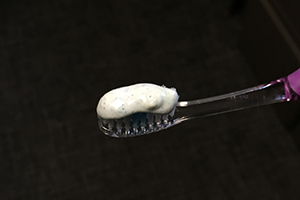What are microplastics?
Microplastics are small plastic pieces less than five millimeters long which can be harmful to our ocean and aquatic life.

Microplastics seen during the 2014 Northwestern Hawaiian Islands marine debris removal mission.
Plastic is the most prevalent type of marine debris found in our ocean and Great Lakes. Plastic debris can come in all shapes and sizes, but those that are less than five millimeters in length (or about the size of a sesame seed) are called “microplastics.”

Microbeads are tiny pieces of polyethylene plastic added to health and beauty products, such as some cleansers and toothpastes.
As an emerging field of study, not a lot is known about microplastics and their impacts yet. The NOAA Marine Debris Program is leading efforts within NOAA to research this topic. Standardized field methods for collecting sediment, sand, and surface-water microplastic samples have been developed and continue to undergo testing. Eventually, field and laboratory protocols will allow for global comparisons of the amount of microplastics released into the environment, which is the first step in determining the final distribution, impacts, and fate of this debris.
Microplastics come from a variety of sources, including from larger plastic debris that degrades into smaller and smaller pieces. In addition, microbeads, a type of microplastic, are very tiny pieces of manufactured polyethylene plastic that are added as exfoliants to health and beauty products, such as some cleansers and toothpastes. These tiny particles easily pass through water filtration systems and end up in the ocean and Great Lakes, posing a potential threat to aquatic life.
Microbeads are not a recent problem. According to the United Nations Environment Programme, plastic microbeads first appeared in personal care products about fifty years ago, with plastics increasingly replacing natural ingredients. As recently as 2012, this issue was still relatively unknown, with an abundance of products containing plastic microbeads on the market and not a lot of awareness on the part of consumers.
On December 28, 2015, President Obama signed the Microbead-Free Waters Act of 2015, banning plastic microbeads in cosmetics and personal care products.
Did you know?
Microplastics can come from a variety of sources including larger plastic pieces that have broken apart, resin pellets used for plastic manufacturing, or in the form of microbeads, which are small, manufactured plastic beads used in health and beauty products.

Microbeads will be banned in Canada as of mid-2018.
Global News
A A
OTTAWA – The federal government says it will ban the sale of shower gels, toothpaste and facial scrubs containing plastic microbeads, effective July 1, 2018.
A notice published Friday in the Canada Gazette serves as final notice on the long-running environmental complaint, and it sets Canada on a timetable that follows the United States for removing the tiny pollutant from Canadian waters.
Microbeads found in natural health products and non-prescription drugs will be prohibited a year later, on July 1, 2019.
Environment Canada began studying the impacts of plastic microbeads on wildlife and the environment under the previous Conservative government in March 2015. The beads were officially declared toxic in June of this year.
The tiny pieces of plastic are used as exfoliants and cleansers in toiletries but do not dissolve. They then find their way into oceans, lakes and rivers where the beads are ingested by a variety of organisms.
WATCH: Federal government says microbeads are toxic
In 2014, about 100,000 kilograms of plastic microbeads were imported into Canada for exfoliants and cleansers, while as much as 10,000 more kilograms were used in the domestic manufacture of personal care products.
Under the proposed change to the Canadian Environmental Protection Act, new regulations will prohibit the manufacture and import of microbeads starting at the beginning of 2018, with the sales ban starting six months later.
The writing has been on the wall for some time and industry has already begun phasing out plastic beads from products.
The U.S. Congress approved the banning of microbeads in toiletries last December, effective July 1, 2017, while the European Union Commission recognized in December 2014 that the materials could not be labelled as environmentally friendly. Australia has a voluntary ban in effect for mid-2018.
The group Environmental Defence applauded the government’s move.
“We are happy to finally say goodbye to these problematic plastic particles that have polluted Canada’s rivers and lakes for far too long, putting fish, wildlife and human health at risk,” spokeswoman Maggie MacDonald said in a release.
WATCH: Cosmetic microbeads contaminating Great Lakes
Nine U.S. states already have passed laws prohibiting the sale and manufacture of beads in personal care products.
According to the Canadian Cosmetic Toiletry and Fragrance Association, a majority of Canadian manufacturers responsible for 99 per cent of the total amount of plastic microbeads used in 2014 have already committed to a voluntary phase-out by the time the federal prohibition comes into force.
© 2016 The Canadian Press


No comments:
Post a Comment